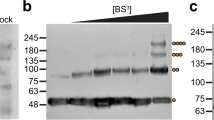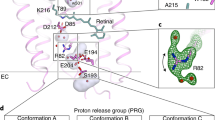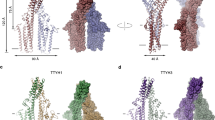Abstract
PDZ domain containing proteins assist formation of cell–cell junctions and localization of membrane protein receptors and ion channels. PDZ domains interact with the C-terminal residues of a particular target membrane protein. Based on their binding specificities and sequence homologies, PDZ domains fall into two classes. The first crystal structure of a class II PDZ domain, that of hCASK, has been solved by multi-wavelength anomalous dispersion phasing. Complex formation with the C-terminus of a neighboring non-crystallographically related PDZ domain reveals interactions between hCASK and its ligand. Class II PDZ domains differ from class I domains by formation of a second hydrophobic binding pocket. The C-terminal carboxylate binding loop of the PDZ domain is structurally conserved in both classes suggesting a generalized carboxylate binding motif (h–Gly–h) where h is a hydrophobic residue.
This is a preview of subscription content, access via your institution
Access options
Subscribe to this journal
Receive 12 print issues and online access
$189.00 per year
only $15.75 per issue
Buy this article
- Purchase on Springer Link
- Instant access to full article PDF
Prices may be subject to local taxes which are calculated during checkout
Similar content being viewed by others
References
Cho, K., Hunt, C. and Kennedy, M.B. The Rat Brain Postsynaptic Density Fraction Contains a Homolog of the Drosophila Discs-Large Tumor Suppressor Protein. Neuron 9, 929–942 (1992).
Woods, D.F. and Bryant, P.J. Molecular Cloning of the Lethal(1)Discs Large-1 Oncogene of Drosophila. Dev. Biol. 134, 222–235 (1989).
Anderson, J.M., Stevenson, B.R., Jestaitis, L.A., Goodenough, D. and Mooseker, M.S. Characterization of ZO-1, a Protein Component of the Tight Junction from Mouse Liver and Madin-Darby Canine Kidney Cells. J. Cell Biol. 106, 1141–1149 (1988).
Kornau, H., Schenker, L., Kennedy, M.B. and Seeburg, P. Domain Interaction Between NMDA Receptor Subunits and the Postsynaptic Density Protein PSD-95. Science 269, 1737–1740 (1995).
Niethammer, M., Kim, E. and Sheng, M. Interaction Between the C Terminus of NMDA Receptor Subunits and Multiple Members of the PSD-95 Family of Membrane-Associated Guanylate Kinases. J. Neurosci. 16, 2157–2163 (1996).
Kim, E., Neithammer, M., Rothschild, A., Jan, Y. and Sheng, M. Clustering of Shaker-Type Potassium Channels by Interaction with a Family of Membrane-Associated GuanylateKinases. Nature 378, 85–88 (1995).
Harrison, S.C. Peptide-Surface Association: The Case of PDZ and PTB Domains. Cell 86, 341–343 (1996).
Kuriyan, J. and Cowburn, D. Modular Peptide Recognition Domains in Eukaryotic Signaling. Annu. Rev. Biophys. Biomolec. Struct. 26, 259–288 (1997).
Gomperts, S.N. Clustering Membrane Protein: Itís All Coming Together with the PSD-95/SAP90 Protein Family. Cell 84, 659–662 (1996).
Sheng, M. PDZs and Receptor/Channel Clustering: Rounding Up the Latest Suspects. Neuron 17, 575–578 (1996).
Pawson, T. and Scott, J.D. Signaling through scaffold anchoring, and adaptor proteins. Science 278, 2075–2080 (1997).
Willot, E., Balda, M., Fanning, A., Jameson, B., Van Itallie, C. and Anderson, J.M. The Tight Junction Protein ZO-1 is Homologous to the Drosophila Discs-Large Tumor Suppressor Protein of Septate Junctions. Proc. Natl. Acad. Sci. USA 90, 7834–7838 (1993).
Jesaitis, L. and Goodenough, D.A. Molecular Characterization and Tissue Distribution of ZO-2, a Tight Junction Protein Homologous to ZO-1 and the Drosophila Discs-Large Tumor Suppressor Protein. J. Cell Biol. 124, 949–961 (1994).
Fanning, A.S., Lapierre, L.A., Brecher, A.R., Van Itallie, C.M. and Anderson, J.M. Protein Interaction in the Tight Junction: The Role of MAGUK Proteins in Regulating Tight Junction Organization and Function. Curr. Topics Memb. 43, 211–235 (1996).
Fanning, A.S. and Anderson, J.M. PDZ Domains and the Formation of Protein Networks, at the Plasma Membrane. Curr. Topics Microbiol. Immunol. 228, 209–233 (1997).
Woods, D.F. and Bryant, P.J. The Discs-Large Tumor Suppressor Gene of Drosophila Encodes a Guanylate Kinase Homolog Localized at Septate Junctions. Cell 66, 451–464 (1991).
Woods, D.F., Hough, C., Peel, D., Callaini, G. and Bryant, P.J. Dlg Protein is Required for Junction Structure, Cell Polarity, and Proliferation Control in Drosophila Epithelia J. Cell. Biol. 134, 1469–1482 (1996).
Muller, B.M. et al. Molecular Characterization and Spatial Distribution of SAP97, a Novel Presynaptic Protein Homologous to SAP90 and the Drosophila Discs-Large Tumor Suppressor Protein. J. Neurosci. 15, 2354–2366 (1995).
Irie, M. et al. Binding of Neuroliginsto PSD-95. Science 277, 1511–1515 (1997).
Dong, H. et al. GRIP: A Synaptic PDZ Domain-Containing Protein that Interacts with AMPA Receptors. Nature 386, 279–284 (1997).
Songyang, Z. et al. Recognition of Unique Carboxyl-Terminal Motifs by Distinct PDZ Domains. Science 275, 73–77 (1997).
Hata, Y., Butz, S. and Sudhof, T.C. CASK: A Novel dlg/PSD95 Homolog with an N-Terminal Calmodulin-Dependent Protein Kinase Domain Identified by Interaction with Neurexins. J. Neurosci. 16, 2488–2494 (1996).
Carey, D.J. Syndecans: Multifunctional Cell-Surface Co-Receptors. Biochem. J. 327, 1–16 (1997).
Ushkaryov, Y., Petrenko, A., Geppert, M. and Sudhof, T.C. Neurexins: Synaptic Cell Surface Proteins Related to the alpha-Latrotoxin Receptor and Laminin. Science 257, 50–56 (1992).
Hoskins, R., Hajnal, A., Harp, S. and Kim, S.K. The C. elegans Vulval Induction Gene Lin-2 Endoes a Member of the MAGUK Family of Cell Junction Proteins. Dev. 122, 97–111 (1996).
Simske, J.S., Kaech, S.M., Harp, S. and Kim, S.K. Let-23 Receptor Localization by the Cell Junction Protein Lin-7 during C. elegans Vulval Induction. Cell 85, 195–204 (1996).
Doyle, D.A. et al. Crystal Structures of a Complexed and Peptide-Free Membrane Protein-Binding Domain: Molecular Basis of Peptide Recognition by PDZ. Cell 85, 1067–1076 (1996).
Cabral, J. et al. Crystal Structure of a PDZ Domain from the Human Homologue of Discs-Large Protein. Nature 382, 649–652 (1996).
Shultz, J. . et al. Specific Interactions between the Syntrophin PDZ Domain and Voltage-Gated Sodium Channels. Nature Struct. Biol. 5, 19–24 (1998).
Hendrickson, W.A. Determination of macromolecular structures from anomalous diffraction of synchrotron radiation, Science 254, 51–58 (1991).
Brunger, A.T. The Free R Value: A Novel Statistical Quantity for Assessing the Accuracy of Crystal Structures. Nature 355, 472–474 (1992).
Leahy, D.J., Erickson, H.P., Aukhil, I., Joshi, P. and Hendrickson, W.A. Crystallization of a fragment of human fibronectin: introduction of methionine by site–directed mutagenesis to allow phasing via selenomethionine, Proteins 19, 48–54 (1994).
Otwinowski, Z. In: Collection and Processing (Sawyer, L., Isaacs, N. & Bailey, S. eds) 56–62 (SERC Daresbury Laboratory, Warrington,UK; 1993)
Brünger, A.T. et al. Crystallography and NMR System: A New Software Suite for Macromolecular Structure Determination, Acta Crystallogr. D, in the press (1998).
Otwinowski, Z. In: Proc. CCP4 study weekend 25-26 January (W. Wolf, P.R. Evans, A.G.W. Leslie, eds.) 80–85 (SERC Daresbury laboratory; 1991).
Phillips, J.C. & Hodgson, K.O. The use of anomalous scattering effects to phase diffraction patterson from macromolecules. Acta Crystallogr. A 36, 856–864 (1980).
Burling, F.T., Weis, W.I., Flaherty, K.M. and Brunger, A.T. Direct Observation of Protein Solvation and Discrete Disorder with Experimental Crystallographic Phases. Science 271, 72–77 (1996).
Wang, B.-C. Resolution of phase ambiguity in macromolecular crystallography. Meth. Enz.. 115, 90–112 (1985).
Zhang, K.Y.J. and Main, P. Histogram matching as a new density modification technique for phase refinement and extension of protein molecules. Acta Crystallogr. A46, 41–46 (1990).
Jones, T.A., Zou, J.Y., Cowan, S. and Kjeldgaard, M. Improved Methods for Building Protein Models in Electron Density Maps and the Location of Errors in These Models. Acta Crystallogr. A 47, 110–119 (1991).
Rice, L.M. and Brünger, A.T. Torsion Angle–Dynamics: Reduced Variable Conformational Sampling Enhances Crystallographic Structure Refinement. Proteins 19, 277–290 (1994).
Pannu, N.S., Murshudov, G.N., Dodson, E.J. & Read, R. Incorporation of prior phase information strengthens maximum likelihood structural refinement. Acta Crystallogr. D, in the press (1998).
Weis, W.I., Brünger, A.T., Skehel, J.J., Wiley, D.C., Refinement of the Influenza Virus Haemagglutinin by SimulatedAnnealing, J. Mol. Biol. 212, 737–761 (1990).
Jiang, J.-S. and Brünger, A.T. Protein hydration observed by x-ray diffraction: solvation properties of penicillopepsion and neuraminidase crystal structures, J. Mol. Biol 243, 100–115 (1994).
Read, R.J. Improved Fourier coefficients for maps using phases form partial structures with errors, Acta Crystallogr. A 42, 140–149 (1986).
Hodel, A., Kim, S.-H. and Brünger, A.T., Model Bias in Macromolecular Crystal Structures, Acta Crystallogr. A48, 851–859 (1992).
Pannu, N.S. and Read, R.J. Improved Structure Refinement Through Maximum likelyhood. Acta Crystallography A52, 659–668 (1996).
Adams, P.D., Pannu, N.S., Read, R.J. and Brünger, A.T. Cross-validated Maximum Likelihood Enhances Crystallographic Simluated Annealing Refinement. Proc. Natn. Acad. Sci. USA 94, 5018–5023 (1997).
Kraulis, P. MOLSCRIPT: A Program to Produce Both Detailed and Schematic Plots of Protein Structures. J. Appl. Crystallogr. 24, 946–950 (1991).
Nicholls, A., Sharp, K.A. and Honig, B. Protein Folding and Association: Insights from the Interfacial and Thermodynamic Properties of Hydrocarbons. Proteins 1, 281–296 (1991).
Bricogne, G. Bayesian Statistical Viewpoint on Structure Determination: Basic Concepts and Examples. Meths Enz.. 276, 361–423 (1997).
Laskowski, R.A., MacArthur, M.W., Moss, D.S. and Thornton, J.M. PROCHECK: AProgram to Check the Stereochemical Quality of Protein Structures. J. Appl. Crystallogr. 26, 283–291 (1993).
Author information
Authors and Affiliations
Corresponding author
Rights and permissions
About this article
Cite this article
Daniels, D., Cohen, A., Anderson, J. et al. Crystal structure of the hCASK PDZ domain reveals the structural basis of class II PDZ domain target recognition. Nat Struct Mol Biol 5, 317–325 (1998). https://doi.org/10.1038/nsb0498-317
Received:
Accepted:
Issue Date:
DOI: https://doi.org/10.1038/nsb0498-317
This article is cited by
-
Autoregulation of the LIM kinases by their PDZ domain
Nature Communications (2023)
-
Two microcephaly-associated novel missense mutations in CASK specifically disrupt the CASK–neurexin interaction
Human Genetics (2018)
-
Structure function relations in PDZ-domain-containing proteins: Implications for protein networks in cellular signalling
Journal of Biosciences (2018)
-
CASK stabilizes neurexin and links it to liprin-α in a neuronal activity-dependent manner
Cellular and Molecular Life Sciences (2016)
-
Mechanistic insight into the functional transition of the enzyme guanylate kinase induced by a single mutation
Scientific Reports (2015)



